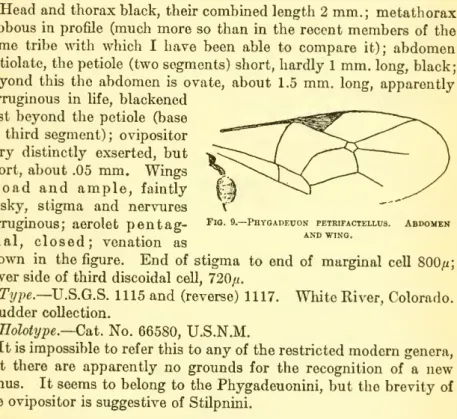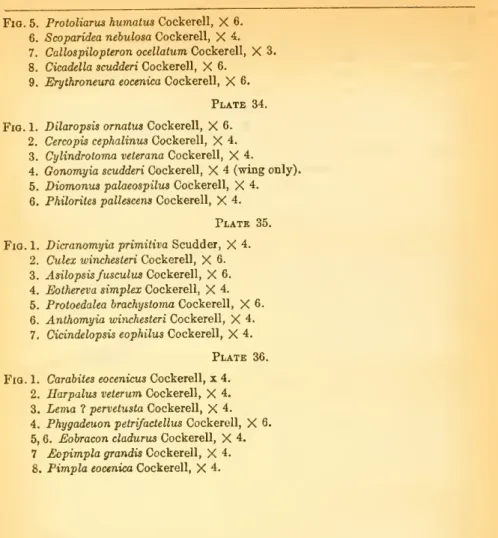The time has not yet come for a detailed summary of the insect fauna of the Eocky Mountain Eocene, but a few points may be noted. Diptera are numerous and include some of the higher families, such as Syrphidae, Anthomyiidae, Oestridae, etc. Although the preserved part of the wing appears superficially dark fuscous everywhere (except the stigma), the cells (especially in the area below the stigma) are have more or less hyaline centers, giving the wing a mottled effect under a lens.
Indeed, it is not clear that the insects are to be separated from Scolypopa; but as this genus is not a member of the present North American fauna, and Hamma'pteryx was based on a very similar insect from the Green River shales of Wyommg, I tentatively place the new species in Scudder's genus. The spot near the end of the radial field is large, and has on the inside a semicircular hyaline spot, the whole effect being an asymmetrical ocellus; about 2 mm. It differs from that of Cerynia hi by a large closed discal cell, such as Distant figures of Atracis emersoniana (Walker) or Gaja inconspicua (Kirby); as in the Gaja, the apical center of the cell issues a vein, but the apical face is angular instead of truncate.
This hind wing is on the rock fragment containing the opposite of the type. Length of tegmina, 11.7 mm.; width, 5.5 mm.; color pale fuscous, with a broad wavy hyaline band across the middle of the disc, broadest on the costa, narrower and more or less G-shaped below, the inner margin fringed with darker brown; apical margin with two large hyaline spots, one upper and one lower, with an indistinct small third between. 244 PROCEEDINGS OF THE NATIONAL MUSEUM. vol.o7. . type species) from it, its acuminate and radiating numerous deUcate oblique veins to the costal margin (the general effect as well as the maculation suggestive of certain Lophopinae); subradius or radial sector, running parallel to the radius and approximately equidistant from it.
Head dark fuscous; tegmina rather pale, with lower margin and base broadly pale brown; middle Costa with.
DIPTERA
A stout-bodied fly, with four black hairs on the scutellum, and the abdomen not bristled. The color of the body therefore corresponds to that of the living Plecia fuMcollis Fabricius, and the wings are also about as dark as in that species. The very long apical petiole of marginal cell, and base of submarginal so close to the anterior crossvein, will at once distinguish it.
The dark cloud in the apical part of marginal cell indicates Leptidae, and is. Rarely elongated flies, similar to TJiereva's general appearance, but with very long slender antennae, the second joint somewhat. Certainly a Therevid, but peculiar to the absence of the cubital fork, about which there is no doubt.
Differs from Oedalea by the simple legs and longer disc, but it is closely related. It is also close to Euthjneura, which differs in the antennae; Coquillett considered Anilialia and Eutliyneura to be inseparable. Venation generally as inmodern SyrpJius, except that the subcostal ceiling is not nearly so slenderly tapering at the apex, the end of the first vein being somewhat as figured by.
There is a distinct but not dark cloud filling the apical part of the subcostal cell, as in The abdominal bristles are not preserved on the reverse impression, which shows only fine hairs in the middorsal region; from this alone one could have gotten quite the wrong impression. It is similar in shape to the living Hyeiodesia lucorum Fallen, with similar long black bristles and short hairs on the thorax and similar wings; but it differs by the shorter bristles.
COLEOPTERA
When we come to compare the extant Cicindelidae, nothing is very close, but the plan of the pattern is similar. The third mark, on the outer margin, is not characteristic of Cicindelidae, but possibly derives from the condition seen in Cicindela guttata Wiedemann. The case is of more than ordinary interest because of the total absence of Cicindelidae in the Florissant (Miocene) shales.
Compared to Pterostichus, this shows little difference except for the absence of the submarginal punctures. inner) stria is displaced laterally near the base and is separated by a ridge from the shortened inner basal stria. In the fossil, the first stria is continuous in a straight line until it passes into the groove along the scutellar margin, described above. I find that in the living Pterostichus menetriesii Motschulsky, of Yuma, the first stria is practically continuous with the inner basal,.
General form and appearance as in Earpalus; the elytra with eight delicatestriae, the marginal one not included; this sharp and not piercing at all. Markings consisting of large black areas covering most of the surface, separated by two narrow transverse colorless bands; there is also a broad humeral dark stripe. The epipleura is colorless below the humeral area, and the dark spots do not extend all the way to the inner margin, which is, however, narrowly fringed with dark.
The transverse light bands (about 0.5 mm.vn-do) are not exactly the same; the first is abruptly turned upwards (basad) at both ends, and on the inner side is separated from the marginal area by a lobe of this second dark spot. The pattern of the present insect with three dark bands so extended as to give the effect of two light bands on a dark ground is not common. Lemma vetusta Heer, a Miocene fossil at Oeningen, is thought by Heer to be a relative of L.
HYMENOPTERA
258 PROCEEDINGS OF THE NATIONAL MUSEUM. cell is relatively large, not strongly acute as in many genera. truly diagnostic characters are italicized. The bend in the basal nerve appears to be a normal feature; if so, that's another useful character. except oviposition); length of thorax approx. 4.25 mm.; forewing from base to end of stigma about 8 mm., probable total length of wing about 12 mm.; length of stigma about 1.8 mm.; lower end of basal nerve to transverse-cubital approx. 4.5 mm., and lower end of basal to basal corner of marginal cell 3 mm,; the width of the petiole of the abdomen about 1 mm. Head and thorax black; abdomen as far as visible light ferruginous, tne base of petiole fuscous;.
The shape of the end of the first brachial cell approaches that of Ischnocerus, and the end of the cell with the subdoscoideus resembles the arrangement found in some ants. Stigma large; two closed submarginal cells, the outer side of the second extremely weak; transverse medial nerve not meeting basal. Head and thorax fuscous (probably black in life); the abdomen is colorless, with a dark scaly tip; antennae slightly more than 3 mm long, much more than basal half colorless, apical part pubescent, apical joint elongate, swollen.
DESCRIPTION OF PLATES

